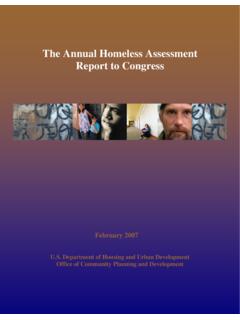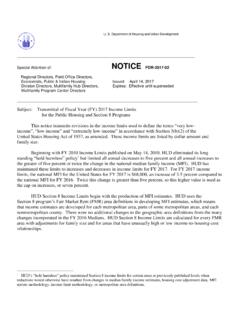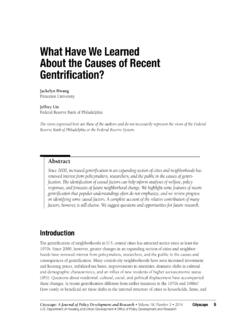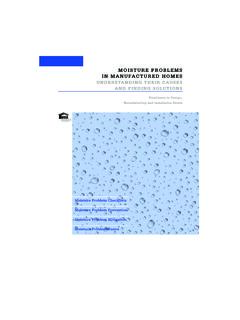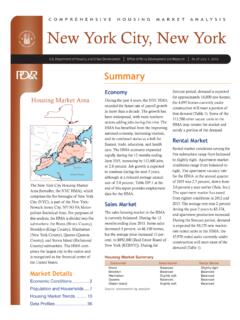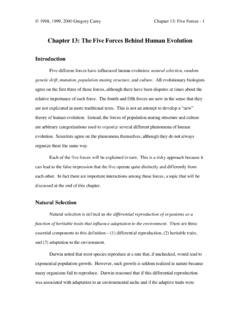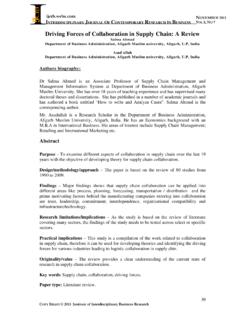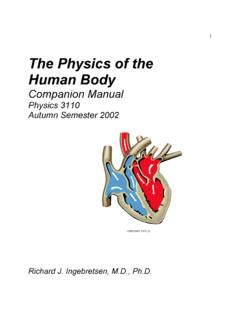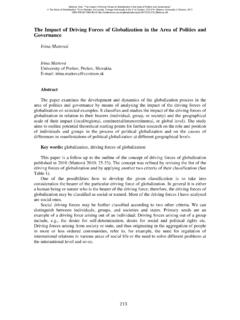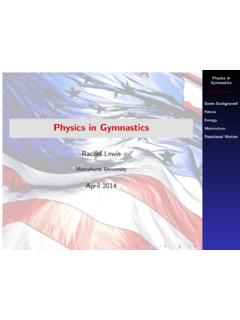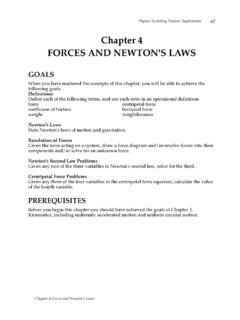Transcription of The Changing Forces of Urban Economic …
1 The Changing Forces of Urban Economic development Cityscape 71 Cityscape: A Journal of Policy development and Research Volume 3, Number 3 Department of Housing and Urban development Office of Policy development and ResearchThe Changing Forcesof Urban EconomicDevelopment:Globalization andCity Competitivenessin the 21st CenturyDennis A. RondinelliUniversity of North CarolinaJames H. Johnson, of North CarolinaJohn D. KasardaUniversity of North CarolinaAbstractEconomic development in cities will be driven increasingly by Forces of globaleconomic interaction in the 21st century. Where the export sector is thriving, interna-tional trade and investment are creating more and better paying jobs.
2 Cities willhave to adjust quickly to these and other international Forces . To grow and prosper,metropolitan areas must improve their education systems to produce a highly skilledand flexible work force , improve the quality of living conditions to attract interna-tional investment, provide services and infrastructure to support globally competitivefirms, and develop stronger entrepreneurial and technological capacity among smalland medium-size companies. Civic leadership and community action are essentialto expanding and modernizing Urban infrastructure, strengthening mechanisms ofcommunity cooperation within metropolitan areas, and fostering public-privatepartnerships to expand opportunities for employment.
3 Demands for integrating theinner-city poor into Economic activities will require innovative policies that buildon business-oriented approaches to community 21st century will be a global century, marked by increasing international trade andinvestment, growing transnational communications, and expanding cross-border alliancesbusinesses and industries. cities seeking to improve or even maintain their economicposition must provide the labor force , services, and infrastructure that allow locally baseddomestic and foreign-owned firms to participate more successfully in the internationalRondinelli, Johnson, and Kasarda72 Cityscapemarketplace.
4 Rapidly expanding global markets will provide our cities and their residentswith immense opportunities to prosper, but only to the extent that their businesses andlabor Forces are prepared to respond to new global in large part by global competitive Forces , the primary engine of Urban economicdevelopment has shifted from one based on mass-production industries and low-skillservice jobs to a more sophisticated technology- and knowledge-based system of produc-tion and services. This shift has provided higher incomes to those workers and managerswho have the skills and knowledge to participate effectively in the new Urban economywhile leaving behind those who do not.
5 Likewise, those cities that become more globallylinked and responsive to the competitive needs of businesses will attract investment andjobs while those that do not will decline. In the emerging global economy, internationaltrade and investment will be key drivers of Urban and regional growth and crucial sourcesof local jobs and the past, Urban economists focused on the domestic exports of cities to areas outsidetheir immediate region, but international trade and investment will play an increasinglyimportant role in the future in Urban Economic revitalization, job generation, and wealthcreation.
6 Miami s Economic recovery, for example, rests heavily on its emergence as animportant transshipment center for goods to and from Latin America and the than 50 percent of trade and nearly 40 percent of all tradewith Latin America now flows through Miami (Jones, 1996). In 1995 alone, Los AngelesCounty gained more than 93,000 jobs and the surrounding areas gained another 50,000jobs through growth in business services, tourism, entertainment, and wholesaling largelyattributed to international trade. Since 1990, more than 300,000 new jobs have beencreated in the Los Angeles metropolitan area (MA) from global trade (Kotkin, 1996).
7 Detroit s Economic renaissance is being driven largely by the sharp increases in interna-tional sales by businesses located in and around the city. Exports to Canada and theEuropean Union from the automobile industry, automotive suppliers, and other high-technology, high-value-added industries in Detroit and other Michigan cities havegenerated almost 500,000 jobs firms in America s largest cities have to some degree always been involved ininternational trade, in recent years a growing number of companies in small and medium-size cities have also become more heavily involved in exporting. The Department ofCommerce reports that by 1995 firms in 253 selected Metropolitan Statistical Areasmade export sales totalling more than $467 billion, an increase of nearly 13 percent overthe previous year ( Department of Commerce, 1996).
8 Approximately 85 percent ofthese MAs recorded export increases. In 1995, 84 of the 253 MAs surveyed includingCleveland and Columbus, Ohio; Flint, Michigan; Fort Worth, Texas; Memphis, Tennes-see; Providence, Rhode Island; Raleigh-Durham, North Carolina; Richmond, Virginia;Salt Lake City, Utah; Syracuse, New York; and Wichita, Kansas reached export salesof $1 billion or more , cities around the country are now competing for foreign direct investment(FDI) by Asian, European, and Latin American firms, whose mergers, acquisitions, andnew plant locations bring with them capital, technology, and jobs.
9 In Ohio, more than200,000 workers are employed by foreign-owned subsidiaries of British, German, andJapanese companies that have invested in the State. In Michigan, nearly 1,000 foreign-owned companies created more than 126,000 jobs in the early 1990s (Thuermer, 1996a).The Changing Forces of Urban Economic development Cityscape 73In addition, American firms in cities around the Nation are finding that, to increase theirworld market share and deliver their products effectively, they must also invest investment can generate revenues that keep the domestic parent company finan-cially viable and stimulate exports through intrafirm trade in cities in which the parentfirm s subsidiaries or affiliates are rapid integration of the global economy will be among the most critical factors shap-ing the viability of Urban economies in the during the coming decade.
10 Investmentwill flow to and exports will flow from those cities that provide better educated andhigher skilled workers, globally linked infrastructures, and flexible and responsible publicand private organizations. In the future, Urban development strategies across America scities must be based on a clear recognition that the international competitiveness of urbanenterprises will create the wealth necessary for job expansion, capital investment, and taxrevenues to support local public services. Wealth creation in American cities will occuronly when both labor and management in Urban enterprises add value to products andservices through technological innovation and increased productivity and move them intothe world market efficiently, effectively, and rapidly.

